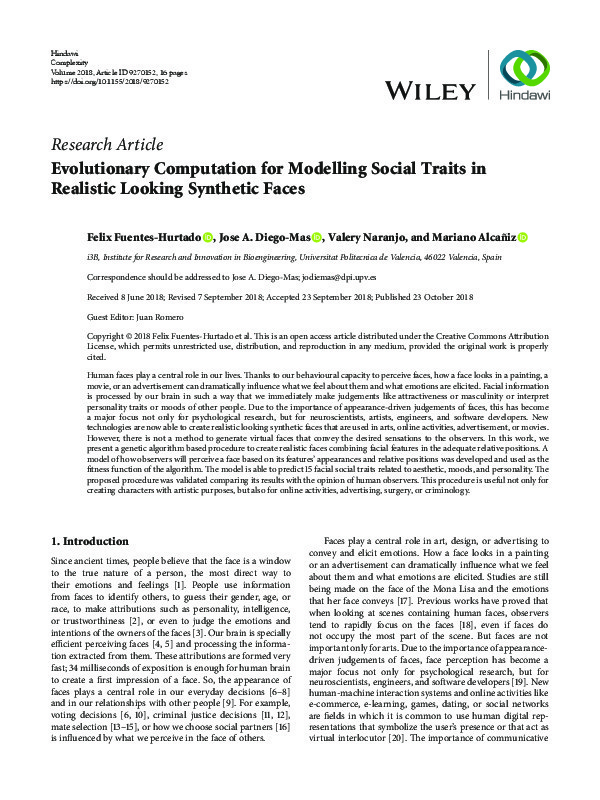JavaScript is disabled for your browser. Some features of this site may not work without it.
Buscar en RiuNet
Listar
Mi cuenta
Estadísticas
Ayuda RiuNet
Admin. UPV
Evolutionary Computation for Modelling Social Traits in Realistic Looking Synthetic Faces
Mostrar el registro sencillo del ítem
Ficheros en el ítem
| dc.contributor.author | Fuentes-Hurtado, Félix José
|
es_ES |
| dc.contributor.author | Diego-Mas, Jose Antonio
|
es_ES |
| dc.contributor.author | Naranjo Ornedo, Valeriana
|
es_ES |
| dc.contributor.author | Alcañiz Raya, Mariano Luis
|
es_ES |
| dc.date.accessioned | 2019-05-31T20:45:15Z | |
| dc.date.available | 2019-05-31T20:45:15Z | |
| dc.date.issued | 2018 | es_ES |
| dc.identifier.issn | 1076-2787 | es_ES |
| dc.identifier.uri | http://hdl.handle.net/10251/121386 | |
| dc.description.abstract | [EN] Human faces play a central role in our lives. Thanks to our behavioural capacity to perceive faces, how a face looks in a painting, a movie, or an advertisement can dramatically influence what we feel about them and what emotions are elicited. Facial information is processed by our brain in such a way that we immediately make judgements like attractiveness or masculinity or interpret personality traits or moods of other people. Due to the importance of appearance-driven judgements of faces, this has become a major focus not only for psychological research, but for neuroscientists, artists, engineers, and software developers. New technologies are now able to create realistic looking synthetic faces that are used in arts, online activities, advertisement, or movies. However, there is not a method to generate virtual faces that convey the desired sensations to the observers. In this work, we present a genetic algorithm based procedure to create realistic faces combining facial features in the adequate relative positions. A model of how observers will perceive a face based on its features' appearances and relative positions was developed and used as the fitness function of the algorithm. The model is able to predict 15 facial social traits related to aesthetic, moods, and personality. The proposed procedure was validated comparing its results with the opinion of human observers. This procedure is useful not only for creating characters with artistic purposes, but also for online activities, advertising, surgery, or criminology. | es_ES |
| dc.language | Inglés | es_ES |
| dc.publisher | John Wiley & Sons | es_ES |
| dc.relation.ispartof | Complexity | es_ES |
| dc.rights | Reconocimiento (by) | es_ES |
| dc.subject | Evolutionary computation | es_ES |
| dc.subject | Genetic algorithm | es_ES |
| dc.subject | Psychology | es_ES |
| dc.subject | Facial social trait | es_ES |
| dc.subject.classification | TEORIA DE LA SEÑAL Y COMUNICACIONES | es_ES |
| dc.subject.classification | PROYECTOS DE INGENIERIA | es_ES |
| dc.subject.classification | EXPRESION GRAFICA EN LA INGENIERIA | es_ES |
| dc.title | Evolutionary Computation for Modelling Social Traits in Realistic Looking Synthetic Faces | es_ES |
| dc.type | Artículo | es_ES |
| dc.identifier.doi | 10.1155/2018/9270152 | es_ES |
| dc.rights.accessRights | Abierto | es_ES |
| dc.contributor.affiliation | Universitat Politècnica de València. Departamento de Ingeniería Gráfica - Departament d'Enginyeria Gràfica | es_ES |
| dc.contributor.affiliation | Universitat Politècnica de València. Departamento de Comunicaciones - Departament de Comunicacions | es_ES |
| dc.contributor.affiliation | Universitat Politècnica de València. Departamento de Proyectos de Ingeniería - Departament de Projectes d'Enginyeria | es_ES |
| dc.description.bibliographicCitation | Fuentes-Hurtado, FJ.; Diego-Mas, JA.; Naranjo Ornedo, V.; Alcañiz Raya, ML. (2018). Evolutionary Computation for Modelling Social Traits in Realistic Looking Synthetic Faces. Complexity. 1-16. https://doi.org/10.1155/2018/9270152 | es_ES |
| dc.description.accrualMethod | S | es_ES |
| dc.relation.publisherversion | http://doi.org/10.1155/2018/9270152 | es_ES |
| dc.description.upvformatpinicio | 1 | es_ES |
| dc.description.upvformatpfin | 16 | es_ES |
| dc.type.version | info:eu-repo/semantics/publishedVersion | es_ES |
| dc.relation.pasarela | S\371045 | es_ES |








